







































Wait. Didn’t our U.S. history textbooks tell us that the British were the bad guys? Let’s see: There was the Stamp Act (“Taxation without representation is tyranny!”)… the “shot heard ’round the world” at Lexington and Concord… the Declaration of Independence.
And yet, 200 years after King George did all of his “taxating without representating,” the Brits finally “conquered” us, this time using guitars instead of muskets.
Owing to the musical movement known as the “British Invasion,” we Yanks greeted the Beatles, the Rolling Stones, the Kinks, the Who, the Yardbirds, et al., with open wallets.
It all began early in the heady year 1964, when Americans were still reeling from the assassination of President John F. Kennedy the previous November. On February 7, the “four lads from Liverpool”— John Lennon, Paul McCartney, George Harrison, and Ringo Starr (as if you needed reminding)— stepped onto the tarmac at JFK Airport in New York City to the screams
Paul, smoking? Naughty, naughty. From left: Paul McCartney, Ringo Starr, George Harrison and John Lennon—collectively the Beatles—in an iconic publicity photo from 1963. © Apple Corps.
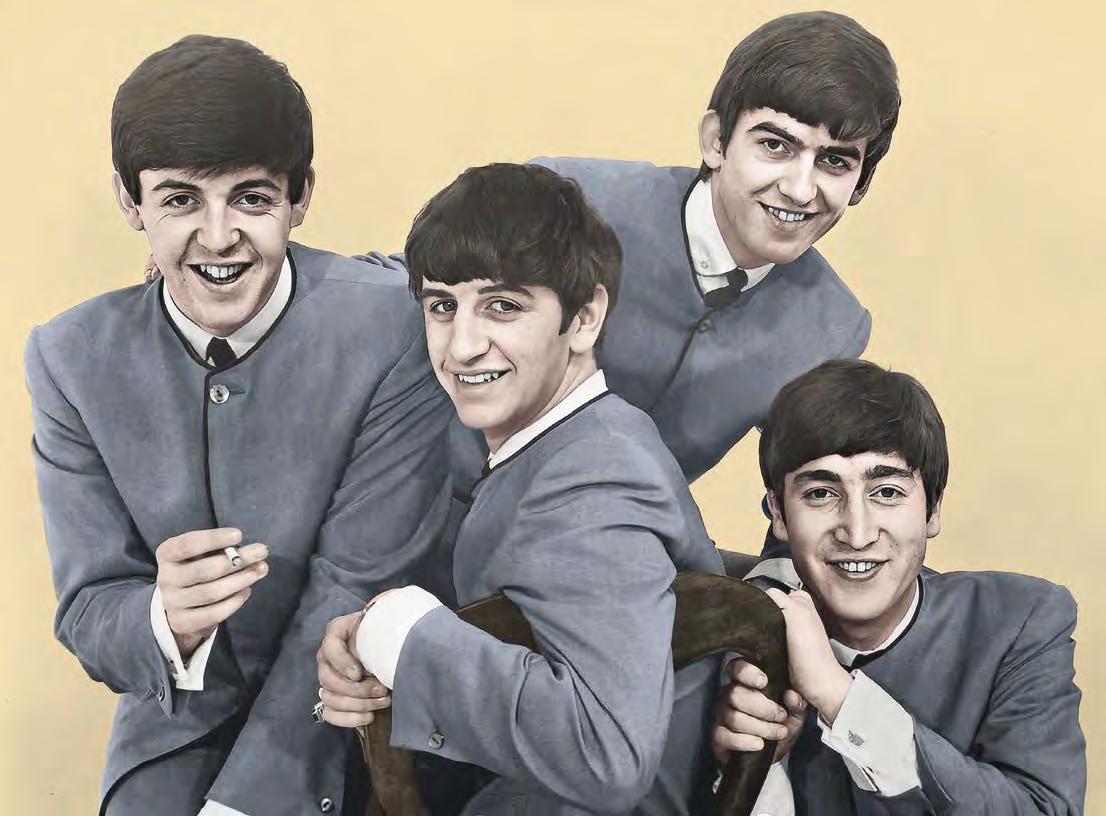
of 3,000 fans, in advance of their American TV debut two days later on The Ed Sullivan Show
“It’s probably one of the many exciting moments I’ve had in my life,” Starr told me in 2001. “To come to America as a musician from England and get that reception was incredible. And that our records were sellin’ in America by then— because we had two that didn’t sell,” he added with a laugh. “It’s just still one of the incredible memories for me. I even felt New York while I was on the plane flyin’ into it. I felt it even from the plane—the engines.”
A makeshift press conference was organized at the airport beneath prominent Pan Am signage. (Product placement out of the box—welcome to America.) But the reporters were antagonistic, with questions fixated on the Beatles’ hair: “Does all that hair help you sing?” “Are you afraid of what the American Barbers Association is going to think of you?”
This didn’t throw the boys a whit. The Beatles merely grinned at their sarcastic questions, and volleyed back with better sarcasm.
Few examples of this initial hostility are clearer than a passage from Newsweek ’s February 24, 1964 cover story: “Visually, they are a nightmare; tight, dandified, Edwardian-Beatnik suits and great pudding bowls of hair. Musically, they are a near-disaster: guitars and drums slamming out a merciless beat that does away with secondary rhythms, harmony, and melody. Their lyrics… are a catastrophe, a preposterous farrago of Valentine-card romantic sentiments.”
There was more, lots more. From the cover of the March 21, 1964 Saturday Evening Post: “Exclusive: Original Beatle fiction by John, the married Beatle. If you think their music bugs you, read this.” (Can you think of another instance in which cover type actually warns potential purchasers that something inside is not worth reading?) Conservative pundit William F. Buckley, Jr. found it necessary to weigh in: “The Beatles are not merely awful; I would consider it sacrilegious to say anything less than that they are godawful.”
Still, magazine publishers found that putting John, Paul, George, and Ringo on their covers guaranteed a boost in circulation. And circulation was the golden calf to said publishers. This unprecedented situation put mainstream American magazines in an inconvenient position. They wanted to maintain their position of moral superiority. But more so,
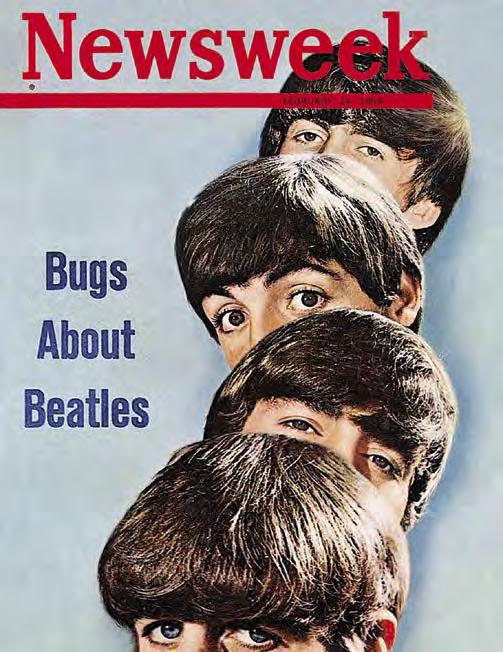
they wanted to sell magazines. Thus the Beatles became both the darlings and the demons of the print-media machine.
The Saturday Evening Post double-dipped with two covers five months apart.
(The Post ’s second Beatles cover had a come-on worthy of 16 Magazine: “THE BEATLES—8 Pages in Color.”) When the Beatles made their pilgrimage to India in search of enlightenment in 1967, Life deemed it cover-worthy.
Beatle business was so good, low-rung publishers began cranking out one-shots with suggestive come-ons (“A date with George, John, Paul & Ringo”; “The girls they want”; “The love code they follow”; “The Beatles answer your most intimate questions”). Lock up your daughters.
The entertainment establishment played ball, if reluctantly. After the Rolling Stones performed on Hollywood Palace, guest host Dean Martin literally rolled his eyes as he said, “Aren’t they great?”
Ed Sullivan may not have been a pop fan, but he knew a good formula when he stumbled onto one. After scoring ratings gold with the Beatles—the group’s February 9, 1964 appearance attracted 73 million viewers—Sullivan brought on more British Invasion acts, one after another. And so the British Invasion was officially in full swing.
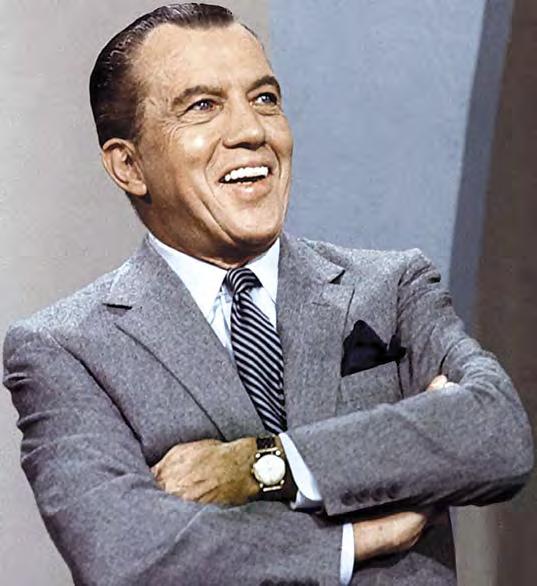
Peter Noone of Herman’s Hermits recalled playing , and a Martin-hosted . “It was a fad, remember,” Noone told me in 2005. “All of the old-timers, to this day, think it’s a fad. The music you hear today, people still say, ‘Oh, it’ll never last.’ So we were a fad. We were replaced by the Monkees, who were replaced by the Osmonds.
“But I think they had a strange kind of respect for us, because we were more talented than they expected. Dean’s son was a fan of the band.
Danny Kaye’s daughter was in the fan club. He showed up in a Herman’s Hermits T-shirt and
TV variety-show host Ed Sullivan presented the Beatles’ U.S. debut on Feb. 9, 1964. © CBS Television.
Beatles manager Brian Epstein (1934–1967) was said to have been, shall we say, overly liberal in approving licensing deals on behalf of his young charges. In America, where the dollar is king, manufacturers seemed willing to plaster the Beatles’ names and faces on just about anything.
There were Authentic Beatle Wigs from Lowell; Beatles Shampoo (“for all the family”) and Beatles Hair Spray (“brushes out instantly”) from Bronson; Beatles magnetic toys from Merit; and Beatles stockings, pens, lariat ties, tie pins, and (note careful spelling) “Beetle” boots.
Also sold were Milton Bradley’s “The Beatles Flip Your Wig” board game, Aladdin’s Beatles lunchbox, and World Candies’ Beatles candy sticks.
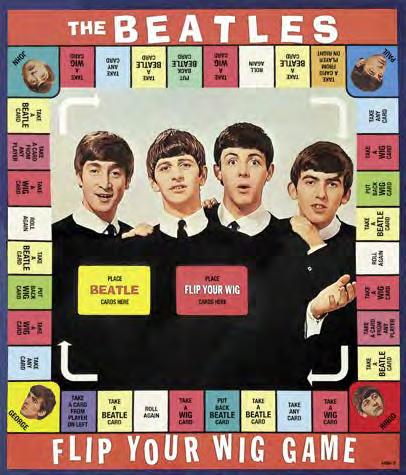
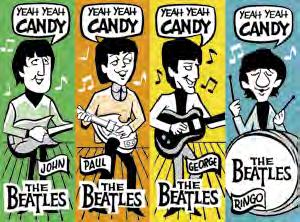
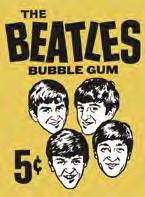
Remco’s darling, wiry-haired Beatle dolls were hot sellers, but their likenesses ran hot and cold. John and Ringo were spot-on. But George had King Charles teeth, and Paul resembled a Zanti Misfit.


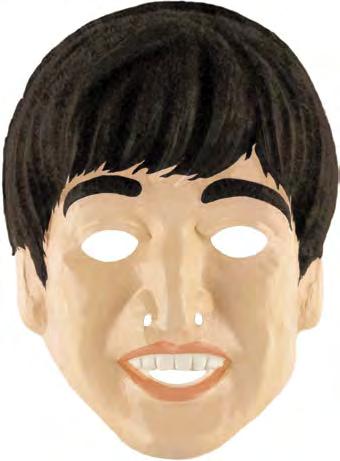
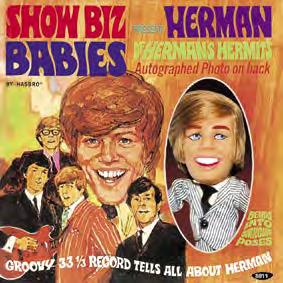
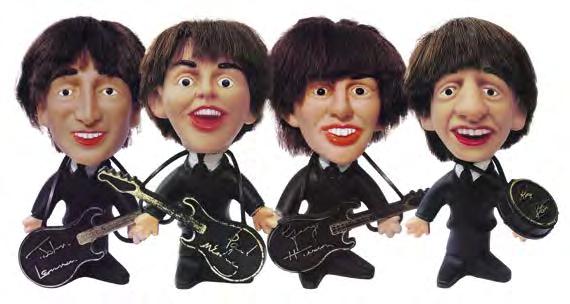
When Ben Cooper—purveyors of chintzy (but enchanting) Halloween costumes—did the Beatles, they did ’em right. The boys were represented in good likenesses on BC’s crackly, rigid, nostrilblocking, sweat-trapping masks. [Editor’s note: Check out RetroFan #2 for our look at Ben Cooper Halloween masks and costumes.]
(LEFT) Ben Cooper’s crinkly, sweat-trapping mask of John Lennon
(BELOW) Elmer
Lehnhardt’s artwork graced Aladdin’s Beatles lunch box (1965).
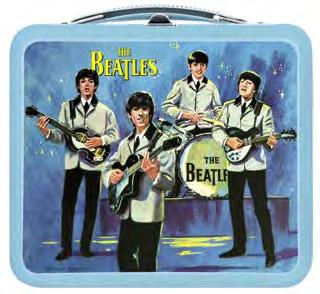
The time is January 1964. United States businessmen are on the lookout for a new fad—something they can manipulate to hawk product in any way they possibly can. Little did they know that their dollarsniffing noses would point in the direction of Liverpool, England!
The Beatles were little known when their first record was released in the U.S. in January 1964, but by the end of the year, well over 30 record albums were being peddled with their name on them, with both earnest and suspicious intent.
EMI Parlophone had released Please Please Me in England in March of 1963. EMI then attempted to get its U.S. counterpart, Capitol Records, to issue a Beatles record. Although Capitol of Canada issued Beatlemania! With the Beatles in 1963, plans for Capitol to release in the U.S. ran aground. EMI then located a small label, VeeJay Records, which agreed to take on the task. Introducing the Beatles (VJLP 1062) became the first Beatles album to be issued in the States, and consisted primarily of 1963’s Please Please Me release.
This move by EMI caused Capitol Records to change their minds and rush out their own album, Meet the Beatles (Capitol T 2047). Funny enough, both albums included the song “I Saw Her Standing There” in their music line-up. The initial pressings of Meet didn’t even take the time to post BMI or ASCAP licenses
(ABOVE LEFT) For many RetroFans, The Chipmunks Sing the Beatles was their first Beatles album! (Coming in RetroFan #31: a look at Ross Bagdasarian’s The Alvin Show!) (ABOVE RIGHT) Consumers looking for Alvin, Simon, and Theodore may have been confused by these Chipmunks on this knock-off album. It certainly wasn’t the only peculiar Beatles-ploitating LP of its day! (INSET) The real Beatles! The Alvin Show © Ross Bagdasarian.
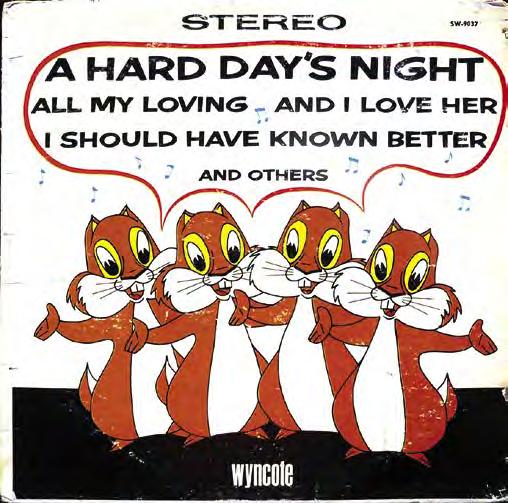
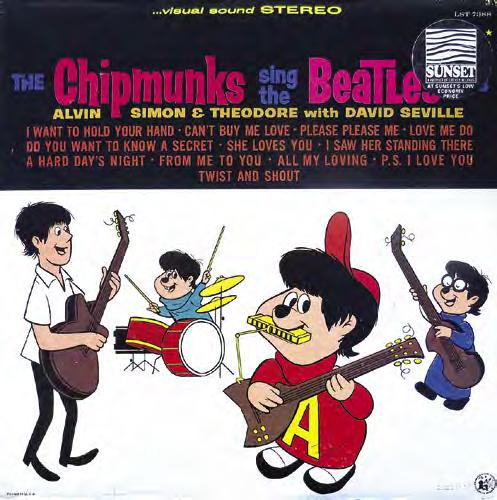

With the Beatles, the second album released by EMI Parlophone, featured the boys’ shadowy visages rather than a bright, cheery photograph. This image would often be the inspiration for copycats later on. While the VeeJay album featured a rather quiet cover from a rather stiff-looking photo session, Meet was noisy with articles as if it was its own press kit. The cover also stated extravagantly that it was the first album by England’s Phenomenal Pop Combo.
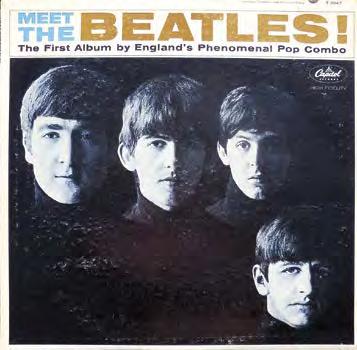
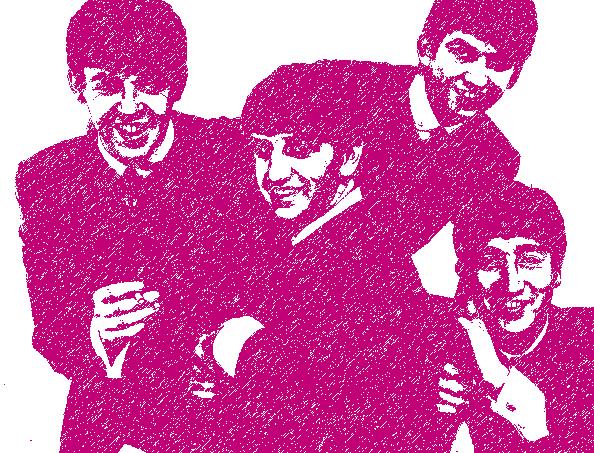
Thus begun the Beatle Battle of 1964. What album (or record company) would sell the most albums of the Fab Four?
Come February 1964, all hell broke loose! The Beatles appeared on The Ed Sullivan Show [see Mark Voger’s column for more info ed.], making viewer history in the amount of people tuning in that night. If you didn’t own a Beatles album yet, the next day surely the

(by copycat band the Princeton Trio), and even Mitch Miller (Sing Along with Art Mooney)! Thus, it was only natural for these labels to try to sell their “Bug Music” to the unsuspecting public.
One of the most popular records of this genre and frequently found in thrift stores is The Beetle Beat (Coronet Records CXS-212), by the Buggs. The front cover features a photo of the “band,” not unlike Capitol’s Meet; the album features a shaded back cover photo as well. While the album does plainly state it is by the Buggs, as does the liner notes, it features two of the Beatles’ big hits at the time, along with a bunch of unknown tracks.
Diplomat Records went to town with the Beatle mop-tops on their album covers: Beatlerama (Diplomat D2307), Beatlerama Vol. 2 (Diplomat 2310), A Hard Days (instead of Day’s) Night (Diplomat D 2335). All feature the identifiable hairstyle and list the Beatles hit
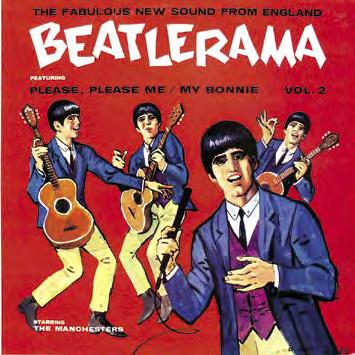
songs, and note “with the Manchesters” in small print. Diplomat’s fourth effort, Ringo’s Theme (This Boy) and And I Love Her (Diplomat DS 2336) is an instrumental album by Al Goodman & His Orchestra. The red cover and Beatle wig make it look quite like the United Artist LP.
A similar touch was featured on Wyncote Records’ Beatlemania! In the USA (Wyncote W9001) by the Liverpools, again with Beatle wigs on the cover, and only four Beatles hits mentioned. The hair became the main motif on albums like The Beatle Beat (AA 133) and Dance and Sing Mother Goose with a Beatle Beat (Golden LP127). These albums follow the trend, yet truly have nothing to do with the Beatles’ style of music at all!
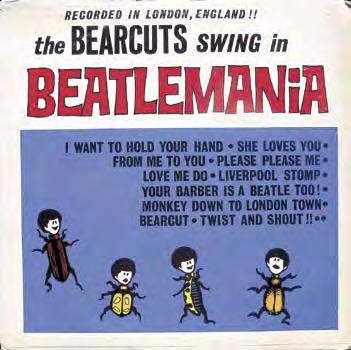
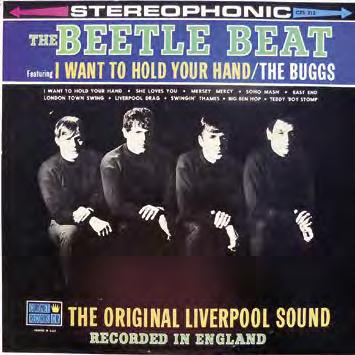
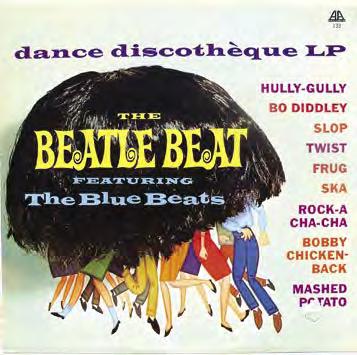
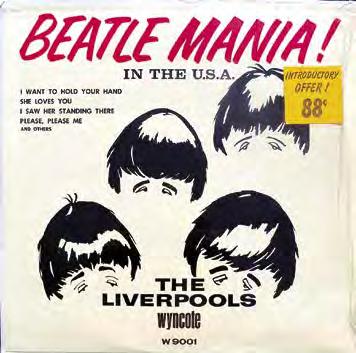
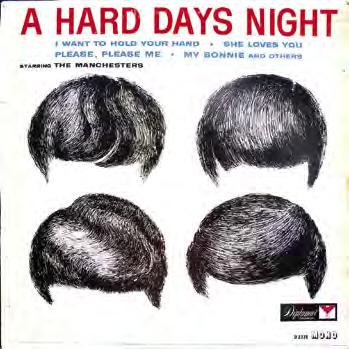
Many of these records were issued combining old trends with new. The Bearcuts Swing in Beatlemania (Somerset p-20800) includes five Beatles hits, yet takes some old surf instrumentals and gives them new titles like “Your Barber Is a Beatle, Too.” B. Brock and the Sultans’ Do the Beetle (Crown CLP 5399) features instrumentals, each containing the word “Beetle” in the title. Some of these companies went to absurd lengths to release a record, yet fail in the packaging. The Schoolboys’ Beatle Mania (Palace 778) was packaged in two different covers featuring a quintet on the cover; the label says the album is by the Moptops. Add to the confusion an album titled Beattle (yes, it is spelled that way) Mash (Palace 208) by the Liverpool Kids, which not only sports an out-of-focus photo on the cover of three older men in Beatles wigs, but the record Label says the album is by “The Schoolboys”!
Bargain-bin absurdities continue with The Beatle Buddies (Diplomat D 2313). Never mind the Bangles—this all-female group look like middle-aged housewives in a shaded Meet-style photo. Like their label-mates the Manchesters, the Beatle Buddies copy some of the same songs for their record, only with a girl-group sound on the vocals. The Beagle and the Four Liverpool Whigs (Sutton ssu 329) displays a Beatle-wigged foursome with their doggie! Unknown musicians also trying to get into the act: The Beatles Song (Globe G-6006), a full Beatles cover album by Gene and the Notes; and the You Know Who Group (International 420), depicting four masked men with that “great new English sound.”
Children weren’t left out of the fold, either. The Chipmunks Sing the Beatles Hits (Sunset LST7388) was just that—Alvin and his friends singing in their high-pitched voices. (This was actually my very first Beatles-ish recording as a child [you’re not alone! —ed ]; I remember we used to play it slow to try


Although I later became a film journalist covering sci-fi and horror movies for Starlog and Fangoria, as a kid I rarely went to the movie theater. Partly because the long-demolished Rialto was so far away, but also because I preferred to spend my allowance on comic books.
However, I do remember going with friends to see the odd film, beginning with Gorgo in 1961 and various other Saturday matinee fare, including some of the beach blanket movies [see RetroFan #22—ed.]. I distinctly remember seeing The Three Stooges Meet Hercules in 1962, and I think I saw one of Steve Reeves’ Hercules epics on the big screen as well. I certainly saw them on TV when they came around to the small screen.
(ABOVE) Behold, RetroFans, as the Mighty Hercules defends Newton and Tewt from a sea serpent (Cecil’s disagreeable cousin, perhaps?). Detail from the cover of Gold Key Comics’ The Mighty Hercules #1 (July 1963). Artist unknown. The Mighty Hercules © Classic Media.
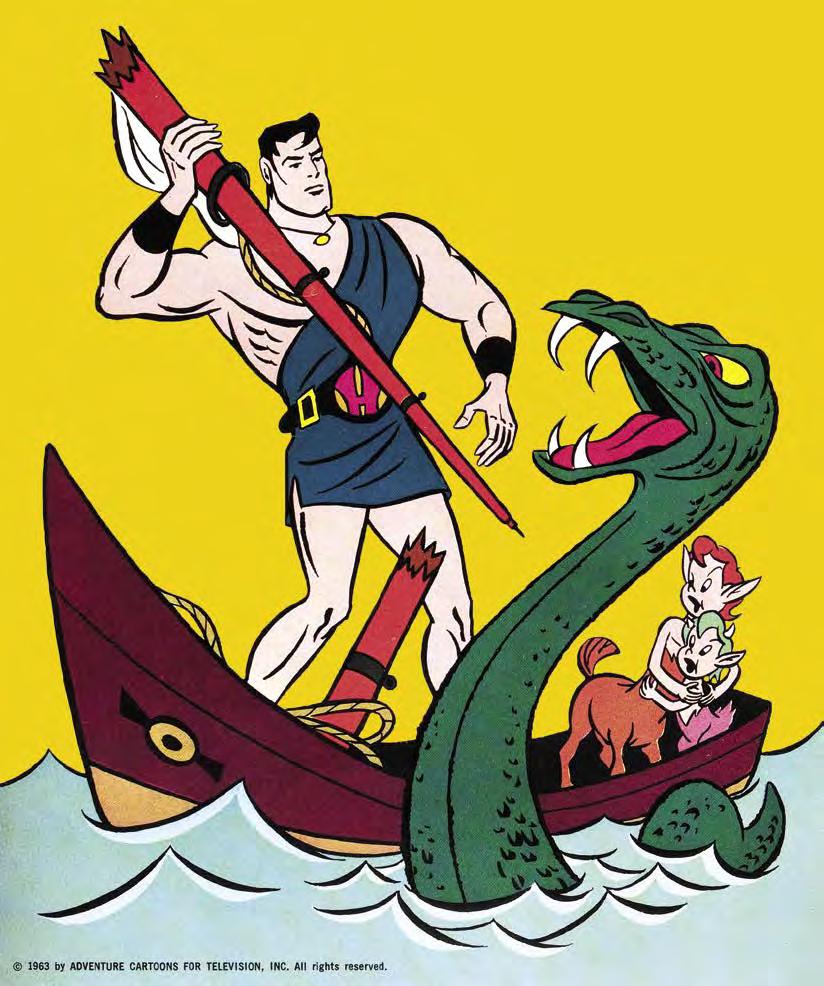
Hercules was a big deal back in those days. He was as popular as monster movies, which were also huge, in all senses of the word. But Hollywood monsters did not have the box-office success of the first Hercules films, which launched a new film genre that was sometimes called “peplum films” because its muscle-bound heroes wore the Greek toga known as a peplos. “Sword-and-sandal movies” is the term by which they are remembered today.
The sword-and-sandal craze had its genesis in a script written in the mid-Fifties by Italian director Pietro Francisci. Francisci had filmed Attila, Scourge of God and was becoming known as the Cecil B. DeMille of Italy, specializing in historical epics.
Hercules Unchained also broke box-office records Wasting no time, Francisci put together another sequel, but Steve Reeves had already committed to a different film. So Francisci went ahead with Italian bodybuilder Kirk Morris as the lead. The parts of Ulysses and Iole were also recast, undercutting continuity with the previous outings.
Released in 1965, Hercules, Ulysses and Samson follows the comrades’ voyage to hunt down a sea monster, during which they are shipwrecked in the Holy Land, where Hercules is mistaken for wanted strongman, Samson. Serious complications follow. As with the previous films, historical reality is completely ignored. These personalities all lived in different eras, B.C. Of course, none are believed to have been real people.
Although Francisci abandoned Hercules after this ad-hoc trilogy, other filmmakers picked up and ran with the character, which was, after all, in the public domain, having preexisted all copyright and trademark laws. Consequently, the early Sixties saw such cinematic concoctions as Hercules Against the Moon Men, Hercules and the Conquest of Atlantis, The Loves of Hercules, and the aforementioned Three Stooges Meet Hercules, in which the Sixties Stooges go back in time to meet the demigod, here played by Canadian Samson Burke.
(LEFT) 1963 trade journal clipping touting the premiere of The Mighty Hercules. (BELOW) During the super-hero craze of the mid-Sixties, Hercules shared this 1967 trade ad with the wielder of the bag of tricks, Felix the Cat. Felix the Cat © Dreamworks Animation LLC. The Mighty Hercules © Classic Media. Courtesy of Will Murray.
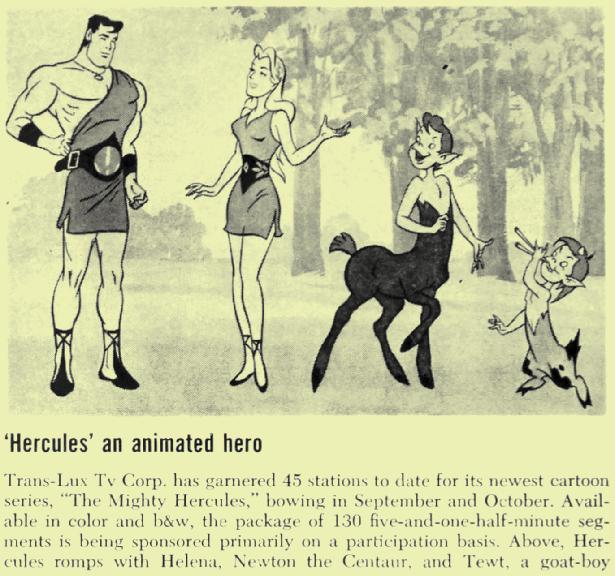
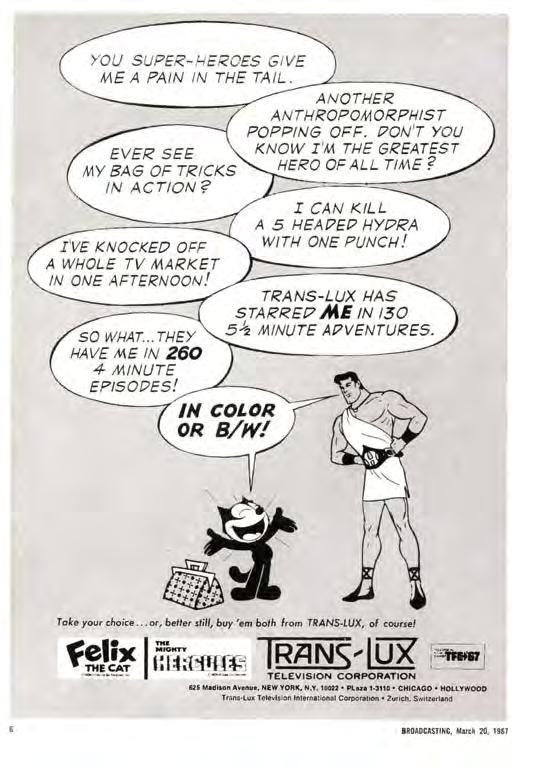
f No. of seasons: Three
f No. of episodes: 130 (five minutes each episode)
f Or iginal run: September 1, 1963–May 1, 1966
f Director: Joe Oriolo
f Studio: Adventure Cartoons for Television, Inc.
f Theme song: “The Mighty Hercules” performed by Johnny Nash
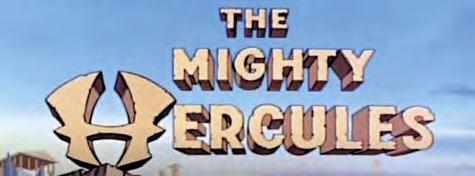
f David Hartman: Hercules
f Jimmy Tapp: Hercules
f Jack Mercer: Daedalus, Newton
f Gerry Bascombe: Daedalus, Newton
f Helene Nickerson: Helena, Wilhelmine
When he defeats Theseus in wrestling, Hercules stands before Zeus, who asks his son what he wishes for a reward. The demigod replies that he wants to go to Earth and help those who are in need. Zeus warns Hercules that he will lose his godly powers on Earth. Seeing his son’s disappointment, he creates a magic ring that will enable Hercules to activate his mighty strength when needed. Normally as strong as an ox, Hercules only has to raise his magic ring to the sky and it appears to attract revivifying lightning bolts called the “thunder of Zeus,” which increases his more-than-mortal strength whenever needed.
Armed with a bow-and-arrow and crude war club, Hercules descends to Earth. The first person he encounters is the beautiful blonde Helena, whom he finds crying because a giant named Cacus has stolen the family sheep. This conflict is straight out of Roman myth. Hercules goes in search of the giant, who he finds carrying a couple of bulls, not sheep, but never mind. When challenged, the giant summons a firebreathing dragon. After plucking his ring from his wide belt and donning it, Hercules clobbers them both, saving the day for the first time. But not the last.
With the second episode, Hercules’ face is redesigned to give him a bigger jaw. Although he retains his blue peplos, his belt and wristbands turn black. The “H” emblem on his belt becomes red against a yellow field. Deliberately or not, this ensemble mirrors the color scheme of Superman’s outfit, right down to the chest insignia. This is not a coincidence. Artist and animator Joe Oriolo, who produced and directed the series, is credited with having done some prop drawing on the Fleischer Studios Superman theatrical cartoons of the Forties [covered by this very columnist back in RetroFan #25 —ed.]. Oriolo claimed that The Mighty Hercules was the first TV cartoon to show realistic characters, but in that assertion he was in error. Clutch Cargo and Space Angel predated the show.
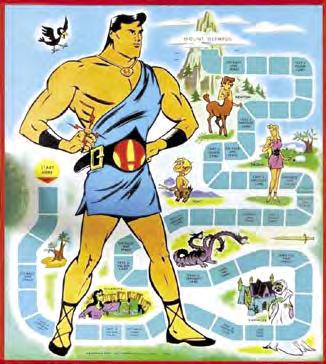
Although The Mighty Hercules was recorded in Montreal, many of the creative people were based in New York City. All 130 five-minute episodes were scripted by a team of DC Comics writers, George Kashdan and Jack E. Miller.
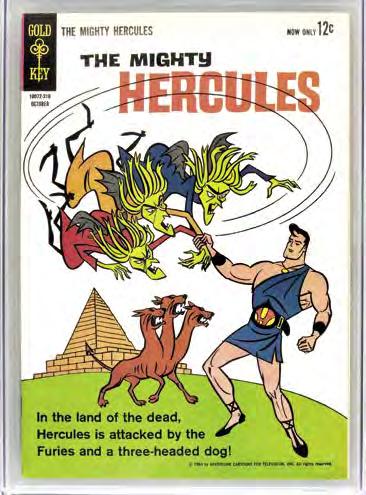
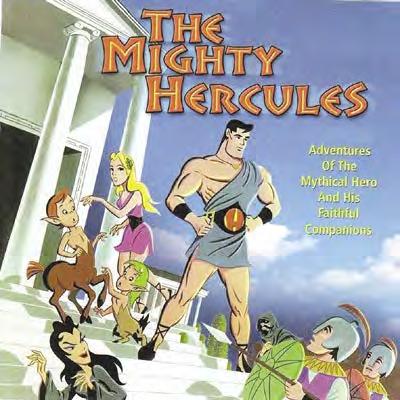
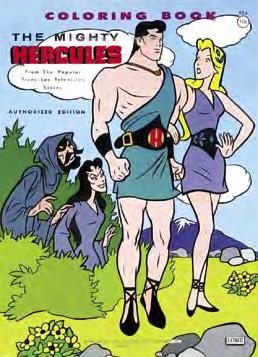
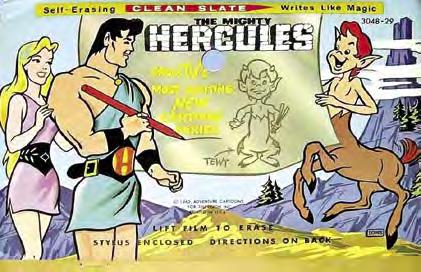
“The Mighty Hercules we wrote for a producer named Joe Oriolo,” recalled Kashdan. “He had drawn Casper the Friendly Ghost and Felix the Cat. He was a
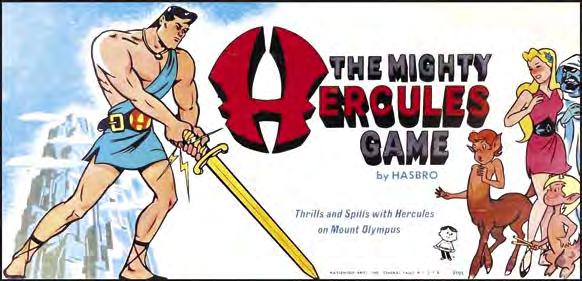
“Hero of ancient glory”—and star of Sixties merchandising! Are any of these Mighty Hercules items in your collection today? The Mighty Hercules © Classic Media. Courtesy of Heritage Auctions, Hake’s Auctions, and Will Murray.

 BY MICHAL JACOT
BY MICHAL JACOT
Television was a huge part of my childhood. I watched its programs as well as its history. I watched as genres peaked, faded, and sometimes returned.
I watched the gimmick sitcoms, comedies with a twist: a family of Universal monsters, a man married to a witch, a beautiful genie in a bottle (who I had/still have a tremendous crush on). Yes, I even watched a couple of episodes of a guy whose mother was reincarnated as an automobile.
I watched Westerns dominate the airwaves. I watched the saga of the Cartwright family and thrilled to Marshall Dillon’s escapades.
And boy-oh-boy, did I watch those Irwin Allen sci-fi dramas! Hapless people adrift in space, tossed through time, stranded among giants… I didn’t watch that stuff, I absorbed it. These shows captured my imagination and held it hostage.
I kept track of it all because my parents subscribed to TV Guide. This digest-sized booklet had great articles on my favorite shows. And, as a kid, there was an added bonus. When the week ended, I got to confiscate the magazine, where I would gleefully blacken out teeth and add stitches and devil horns to the photos of those glamorous television stars. (Ha! How about that, Marlo Thomas? Not so cute with crossed eyes and an Alfred E. Neuman smile, are you?)
But there was always one issue I never defaced. That was the one that arrived around the first week of September. The TV Guide Fall Preview.
As a TV addict, I was obsessed with the Fall Preview. It was a peek into the future, what to expect in the next few weeks. The spotlight on each new show detailed the plot, the characters, the stars, and a cool photograph of the cast.
The fun of Fall Previews is seeing the progression of television history. Keeping RetroFan in mind, this article will mainly focus on those issues from the beginning to the early Eighties. You know—those years with all the good TV.
The first Fall Preview (1953) was a huge hit with fans, and it didn’t take TV Guide long to plan this as an annual affair. That inaugural edition clocked in at a mere 32 pages. Stations generally began broadcasting at around 7:00 a.m.; some didn’t begin their day until 9:00. Most closed up shop around midnight or 1:00 a.m. Because of the sparse schedules, that first Fall Preview looked a lot different
(LEFT) A TV Guide Fall Preview sampler. All scans accompanying this article are courtesy of Michal Jacot. © TV Guide.
“As We See It” made a rather dramatic prediction: “This season could mark either the beginning of TV’s second Golden Age or the end of serious efforts to upgrade the medium with special programming.” While it wasn’t exactly a serious effort, there was one show that debuted in the Summer of Love that changed television habits in a roundabout way.
By 1969, everything was groovy and TV was just starting to reflect real-life issues in their situation comedies. Producer Sherwood Schwartz read that 29% of all marriages included a child or children from a previous marriage. With that in mind, The Brady Bunch was announced in the 1969 Fall Preview. While it was still the same fluff that had always been on TV, it was an attempt to depict trending family dynamics and a subtle step in a direction that would lead to meatier fare like All in the Family and Maude in just a few short years.
An interesting missive in that issue’s letters column showed that viewers were taking their TV seriously. William Cook wrote, “Why can’t more TV shows follow the fine example set by The Fugitive? Instead of just ending the season with another rerun, why couldn’t shows like The Time Tunnel film a special episode and save it for the end of the season? … There are, have been, and will be many more shows that could end with a real ending.”
Mr. Cook echoed my sentiments. I still think of those people still stranded on Gilligan’s Island, the Robinson family still Lost in Space, and the crew of the Spindrift still getting trampled in a faraway Land of the Giants
The 1980–1981 issue was a bulging 84 pages, and the last one to be spine-stapled. The next year, it would change to a squarebound
(LEFT) By 1965, Fall Previews eschewed group shots for separate photos of new shows and their stars. © TV Guide. (BELOW) Gilligan’s Island and its earworm theme song premiered in 1964. Tina Louise’s contract stated that she would be billed fifth in the roll call of castaways, and that nobody would be billed after her (perhaps so her name, being the last one heard, would be remembered). Russell “Professor” Johnson and Dawn “Mary Ann” Wells arrived late to negotiations to find their characters couldn’t be named before or after Louise’s, so they became “… and the rest.” Fortunately, the song was corrected by the next season and the duo got their well-deserved name-check. (Source: televisionacademy.com.) Gilligan’s Island © Warner Bros.
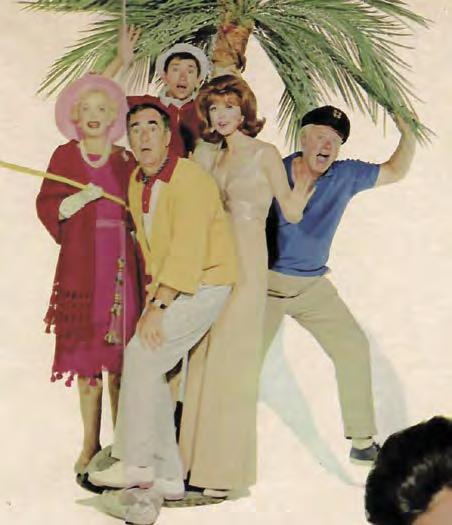
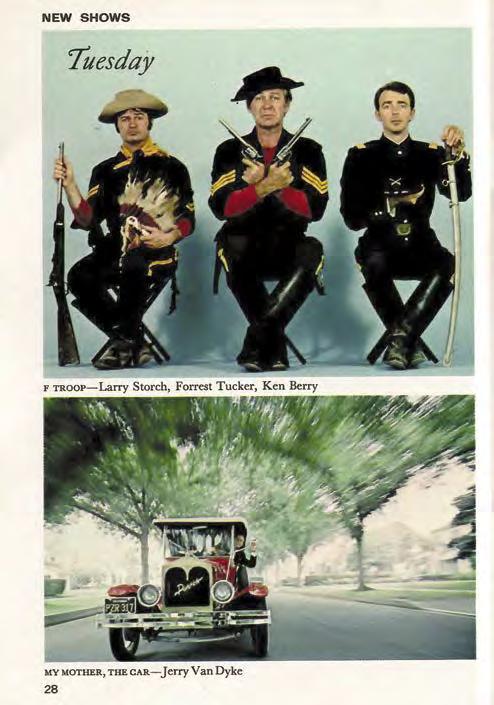
format; with more TV to cover, Fall Previews got thicker and thicker. Since their switch to standard magazine size, we no longer see these chunky annuals. Personally, I miss the digest-sized issues.
I reached adulthood (maturity came later) and struck out on my own. I got an apartment slightly larger than my car, and as a newly minted Responsible Adult, I started my own subscription to TV Guide
There was my weekly dose of TV info, delivered right to my door. But it wasn’t Mom and Dad’s magazine any more. Now I was getting those Fall Previews, and they were mine, all mine.
I kept that first Preview issue from my subscription, from 1977. Then I kept the next year. And the next. And just like that, a collection started.
Soon I was married, and my wife knew my special TV Guide would arrive every September, and that I would add it to my burgeoning collection. I regretted not saving all of those great issues when I was growing up. My dream was to have every Fall Preview, starting with their first one in 1953. I searched comic-cons, antique stores, and flea markets, with very few “hits.”
And then eBay came along. Ah, yes… online auctions and my disposable income. What a combination.
By the late Seventies, the Fall Previews edition was easily the figure of authority when it came to television viewing. 1977’s annual offering told readers that “in place of violence, you’ll find more comedy, more fantasy, more family drama—and more sex. Onscreen advisories about ‘adult’ content will be very much in evidence.” While my parents bemoaned this trend toward “Jiggle TV,” my 20-year-old raging hormones just said, “Bring it on!”
Diamonds Are Forever (1971) marked a return to form and the end of an era for the James Bond franchise; after producers refused to meet leading man Sean Connery’s salary demands following You Only Live Twice, he was replaced by Australian model George Lazenby for 1969’s On Her Majesty’s Secret Service. While the 1969 film is one of the best in the series, audiences just didn’t take to the new guy onscreen. When Lazenby went rogue and announced he wouldn’t return to the part of the world’s most famous secret agent, producers Cubby Broccoli and Harry Saltzman found themselves over a barrel; they needed a Bond, and quickly—a Bond who could right the franchise’s sinking prospects as the Sixties spy craze waned and drew its final breaths. The duo lured a visibly aging Connery back for one last hurrah as MI6 agent 007, and sent him stateside to get to the bottom of a diamond smuggling ring that smacked of old nemeses SPECTRE [Special Executive for Counter-Intelligence, Terrorism, Revenge and Extortion; herewith Spectre —ed.]. Along the way, Bond gets pulled into their bid to use the assets and influence of reclusive billionaire Willard Whyte to hold the world hostage with a killer laser weapon satellite made with the diamonds.
Kidnapped by Spectre commander Ernst Stavro Blofeld (who has been impersonating him), Whyte has been imprisoned in a fabulous modern home in the Nevada desert, watched over by a pair of lovely but deadly jailers, Bambi and Thumper. The pair are ultimately subdued after throwing Bond into the pool, but before that they savagely—and stylishly—beat him to within an inch of his life. Gymnast Lola Larson acquits herself well as Bambi, but the real standout in the scene is Thumper, as portrayed by dancer and actress Trina Parks, who became the first Bond girl of color in this movie.
Watch out, 007, here comes Thumper! Signed Trina Parks publicity photo from the 1971 James Bond movie, Diamonds Are Forever © Eon Productions. Unless otherwise noted, all images accompanying this article are courtesy of Anthony Taylor and/or Trina Parks.
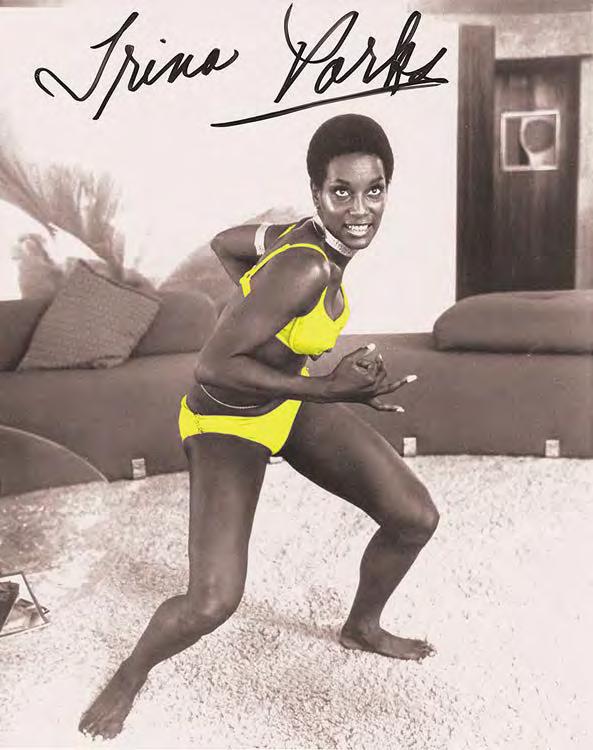
Trina Parks was born in Brooklyn, New York, on December 26th, 1947. The daughter of renowned Jazz saxophonist Charles Henry “Charlie” Frazier, it was inevitable that she would eventually pursue a career in the arts. Frazier was a Cotton Club regular, and played for and with such luminaries as Cab Calloway, Jimmy Dorsey, Dizzy Gillespie, Count Basie, and many more.
From a very young age, Trina loved to dance. “My father started taking me to the Brooklyn Academy of Music to start ballet classes when I was about six,” she says. “He was out of town a lot [performing], but when he was home, he always made sure to take me there himself. I’ve been dancing ever since.”
Continuing with her studies, she moved into Jazz and African dance classes, eventually auditioning for the High School for the Performing Arts (of Fame fame), to which she was admitted enthusiastically. As she matriculated there, she also began taking classes several afternoons a week at the Katherine Dunham school a few blocks away, where her talents bloomed. Dunham was one of the most popular dancers, choreographers, and dance teachers of the time. She originated the role of Georgia Brown in the Broadway production of Cabin in the Sky. She and her dance troupe performed in many theatrical shows and reviews both in New York and across the country, and in motion pictures such as Star Spangled Rhythm, Pardon My Sarong (with Abbott and Costello), and Stormy Weather. Dunham became Trina’s mentor.
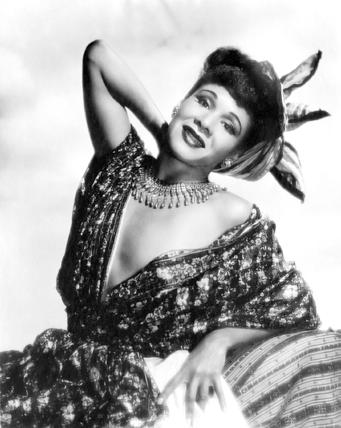
“You always wish to be younger, but if I had been younger I would never have had the opportunity to study with Ms. Dunham,” she muses. “I feel so lucky that I was able to learn from her.” After graduating high school, Trina joined the final iteration of the Dunham dance troupe, performing all across the country and eventually spending a year in Paris. Parks has been engaged as choreographer for the upcoming film Eartha Kitt C’est Si Bon, a biopic of Kitt who was another of Dunham’s protégés. Ashlee Olivia Jones will portray Kitt, with Robert Beltran set to play Orson Welles. As a dance instructor herself, Trina has taught the Dunham technique since 1970, honoring the legacy of Katherine Dunham who passed away in 2006.
A part as a dancer in Martin Ritt’s film The Great White Hope brought Parks to California in 1970, under the supervision of choreogra-
Parks (RIGHT) with David Carradine and David McCallum in a screen capture from “The Phantom Farmhouse,” Season 2, Episode 5 of television’s Night Gallery. Original airdate: October 20, 1971. © Universal.
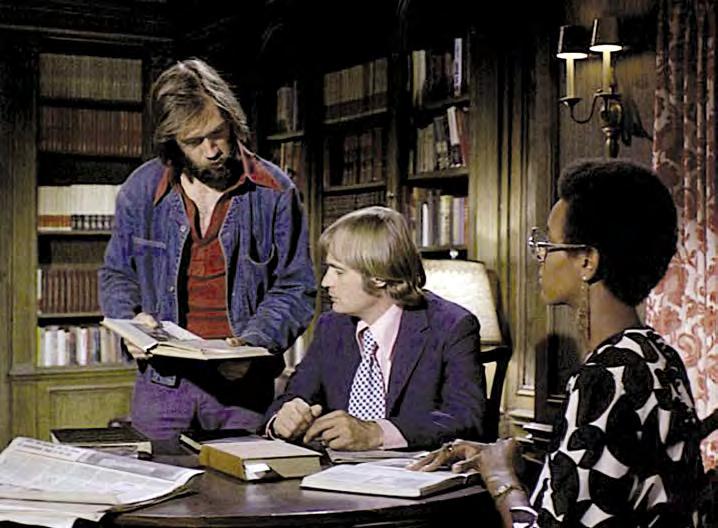
pher Donald McKayle, in whose company she had danced following the return of the Dunham troupe from Europe. “That was the first time I’d gone to Los Angeles, and I loved it!,” she says. “I loved the weather, never liked the cold, so I stayed and created my own act at the Ulysses Club in Beverly Hills, and that’s how I got an agent in Hollywood.” First up for Trina was a background part dancing in Beyond the Valley of the Dolls.
Soon, she landed a co-starring part alongside David Carradine and David McCallum, in an episode of Night Gallery called “The Phantom Farmhouse,” directed by Jeannot Szwarc. “I didn’t have too much interaction with David Carradine except for the scene of all of us in the trees, but I really enjoyed working with both of them,” Parks reveals.
Then came Bond. Trina got a call from her agent, Marty Klein, saying the producers of Diamonds Are Forever were casting the character of Thumper, and he felt she might be right for it. “He knew I had dance experience but he didn’t know if I knew karate,” she recalls. “So I said, ‘Yeah! I know Haitian karate,’ which I had learned from Ms. Dunham.” Klein forwarded her bio, and she was interviewed, screentested, and producers Broccoli and Salesman were sold. They offered her the role that would be her signature performance. “I had so much fun doing that part. And it was the first time I had been on a set where there was more than just a few people—there were a lot of people on this set!”
Trina has high praise for producer Cubby Broccoli, director Guy Hamilton, and especially stunt coordinator Bob Simmons. “[Simmons] said, ‘I’m not a dancer, so show me what you have, show me what you can do’, and that was for the shots where I was on the floor stalking Sir Sean,” she remembers. The pair tried several
different combinations of moves and actions, and Broccoli and Hamilton picked what they liked for the scene. The company then took the better part of two days to block all the movement and camera coverage and shoot the bulk of the scene before breaking for the weekend, to return Monday for the final day of shooting in the swimming pool. “Lola did all of her own stunts because she was a gymnast, my stunt lady had to do the dive into the pool because I was SAG (Screen Actors Guild, the actors union) and Lola wasn’t at the time, so she was performing ‘Taft-Hartley’ (a SAG permit that producers file for non-union performers with special skills) and she was just wonderful. Richard E. Butler was Sir Sean’s stunt
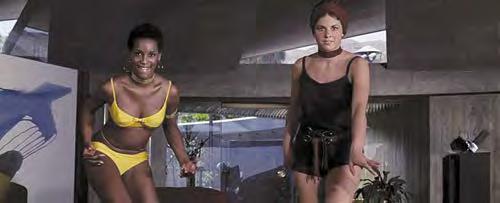
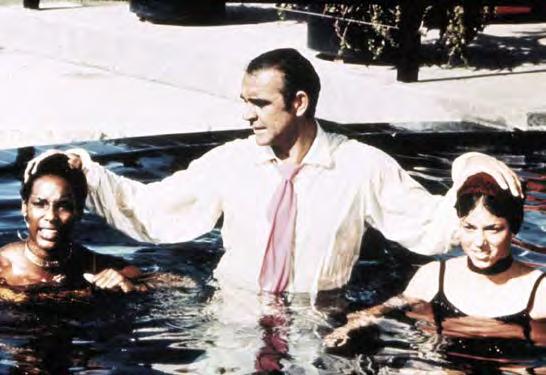
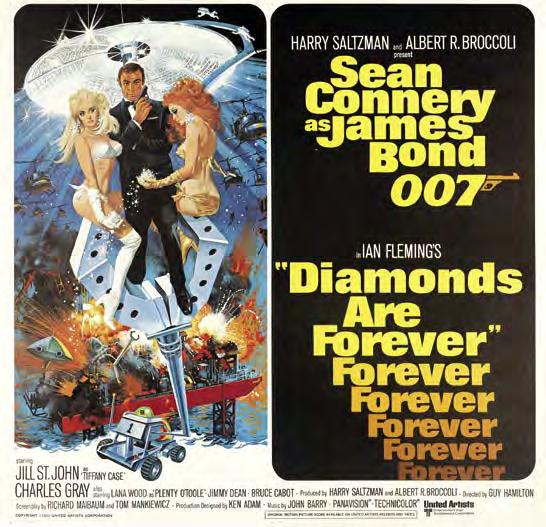
double and he really looked like him on camera!” Butler took all the punishment dished out by the ladies, including several wicked kicks and judo tosses.
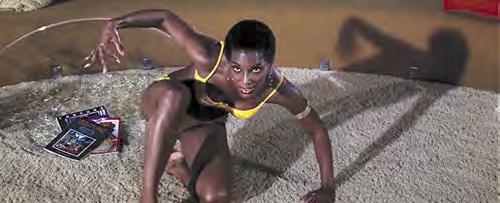
The Elrod House in Palm Springs, California, was used for the location, and the modernist masterpiece home kept cast and crew entranced… and on their toes. “Those were all real rocks in the scene, the house was built on them. If anyone took a tumble the wrong way, it could have been really dangerous,” Trina recalls. The circular, vault-like living space is as unforgettable as the action that takes place within it in the film. The house was designed in 1968 by John Lautner, a protégé of Frank Lloyd Wright, and commissioned
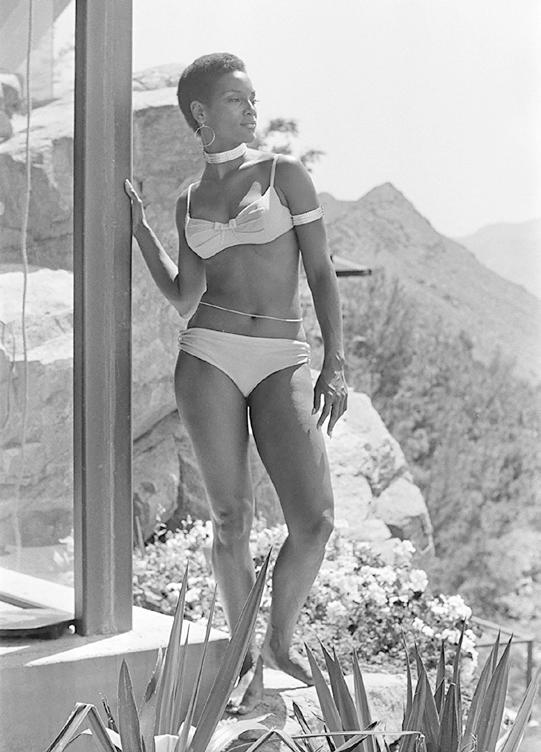
The story of the Frito Bandito (a one-time cartoon mascot for Fritos corn chips), my father’s short stint as a Keystone Cop, and me meeting the widow of Pancho Villa all happened within the space of a few years. The events, disconnected though they may seem, are related by forces beyond my control. Actor Ricardo “Khaaaaaan!” Montalbán makes an appearance, as do a couple of extremely honked–off bulls and Mae West’s apartment (but not all at the same time, I mean, be real). Also, there is a hairbreadth escape from jail and a futile hunt for a bandit.
I will not be making any of this up.
Here at the Secret Sanctum, a lot of time is spent thinking about the past. Most memories make me smile or make me shake my head, dumbfounded. The Frito Bandito story manages both. Smiles because the Frito Bandito’s commercials had a catchy jingle [see RetroFan #25 for more catchy commercial jingles —ed.], and I shake my head because, boy, the minds behind this cartoon mascot really weren’t reading the room (the room being the Sixties). The fact that his appearance made the pages of A Short Course in International Marketing Blunders: Learn from the Mistakes of Others by Charles
Mitchell (World Trade Press, 2001) should give you a hint of the Frito Bandito’s final fate. He may not have been an active mascot for long, but he refused to leave the party for longer than anyone expected.
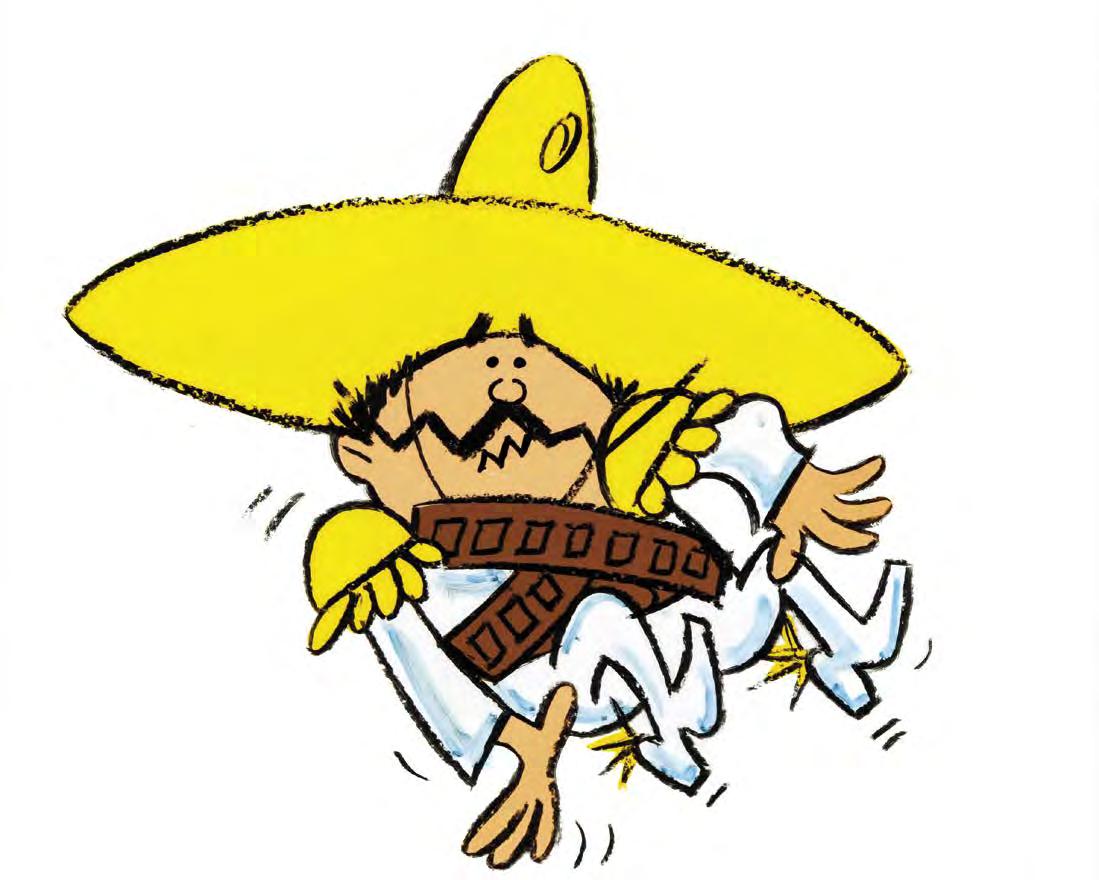
The Frito-Lay company, makers of yummy Fritos corn chips and other salty snacks, had hit a bad patch of publicity in the Sixties that they wanted to put in the memory hole. There were claims against the company for overcharging smaller business partners, indictments for extortion, and a grubby little episode involving peanut oil (it was an attempt to corner the market—what were you thinking of?). Management felt that the company’s reputation needed a spit-shine,
Frito-Lay’s Frito Bandito quickly became a large headache for the popular snack company. Production cel from an animated commercial, circa 1969. © Frito-Lay North America, Inc., a Division of PespiCo (herewith Frito-Lay). Courtesy of Heritage.
and Fritos corn chips became a part of that effort. Frito-Lay both retired its first mascot, the Frito Kid, and introduced the Frito Bandito in 1967.

The Bandito was dressed in a simple white outfit and armed with a couple of pistols. He had two bandoliers wrapped across and around his chest. His smile was menacing, highlighted by a gold tooth, and adorned with a long, pencil-thin mustache. He was unshaven and wore a large sombrero. He spoke with a very exaggerated South of the Border accent. And—at gunpoint—the Bandito wanted to take your Fritos, which he liked because they were “croonchy.”
And now, the jingle:
Ay, ay, ay, ay! I am dee Frito Bandito. I like Frito’s corn chips. I love them, I do. I want Frito’s corn chips, I’ll take them from you.
The jingle is sung to the tune of the traditional Mexican song “Cielito Lindo” (also know as the “Ay-ay-ay-ay” song), and it or variations were heard in various Frito Bandito commercials.
The target audience was kids. The jingle was just a happy, easily repeatable song that was supposed to pop into our heads when we saw a bag of Fritos corn chips. And it did. The reaction was strong enough that Frito-Lay expanded the advertising campaign beyond commercials on children’s programs toward a general audience.
The Frito Bandito was not particularly unique in the advertising world. Other companies used exaggerated Mexican or other Latino characters selling their products, too. Bill Dana, in the guise of his popular Bolivian “José Jiménez” character, shilled for the Yellow Pages. Mexican-style bandits appeared in commercials for products like cigarettes and underarm deodorants (“If it works for them, it’ll work for you”).
Responding to growing concerns about his dimwitted Latino character, Dana, who was of Hungarian Jewish “extraction” (as we used to say), announced the end of “José Jiménez” at a Mexican-American pride festival in 1970, performing as his career-defining creation only one more time after that. Dana also wrote the “Sammy’s Visit” episode of All In the Family (you know, the one where Sammy Davis, Jr. kisses bigot Archie Bunker—television’s other big biracial kiss of my youth).
American Motors was another company knocked for its use of bad cultural stereotypes in its ads, but denied the claim. Advertising and Sales
(RIGHT) Pancho Villa in popular culture: Publisher Avon’s Pancho Villa one-shot comic book (Nov. 1950), with cover art by painter of presidents Everett Raymond Kinstler; and the poster for the Wallace Beery picture Viva Villa! (1934), the second time the actor portrayed the bandit, having previously done so in the silent film Patria (1917). Viva Villa! © MGM. Courtesy of Wikimedia.
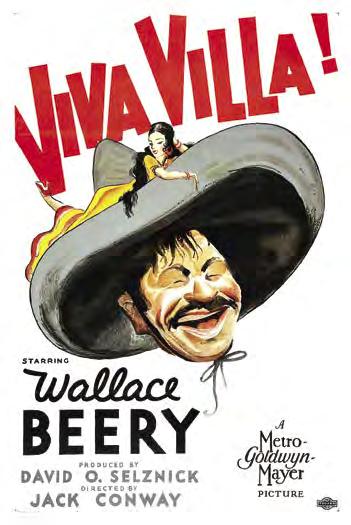
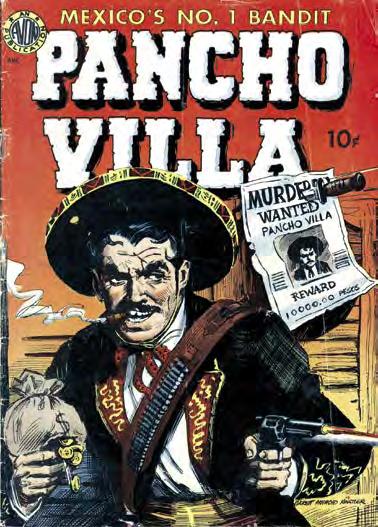
Promotion, a trade publication, reported in its September 1969 edition that American Motors pronounced with a straight face that its offensive characters were not Mexicans, but rather Turks or maybe Hungarians.
But here’s the key thing about cartoon mascots and selling product: You want an appealing character that makes consumers think positively about your product. If we learned anything during the Sixties is that voices for better, fairer representation were growing and getting louder.
The Frito Bandito was designed, first and foremost, to provide a positive association to corn chips. It’s true that all cartoon characters are exaggerations or simplifications of one sort or another. But the Bandito (more properly “bandido” in Spanish) was a “cute” rendition of a Mexican revolutionary, circa 1910–1920 of which Pancho Villa was the most famous. Villa was beloved by
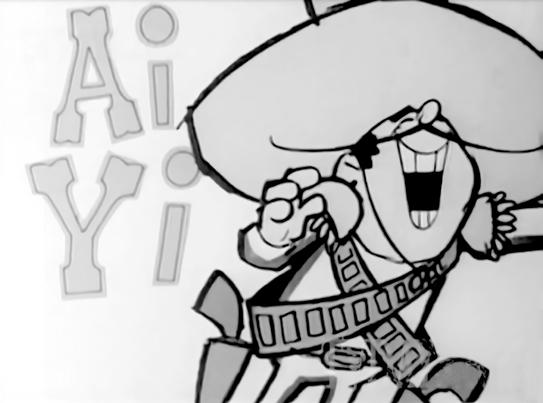
some as a hero who helped remove a dictator from power… but he was also a thief, a kidnapper, and a killer (just sayin’). Villa’s violent reputation was such that my wife Ruth’s paternal grandfather was released from a Mexican jail along with another American national (there is a story here, but no one in the family knows it) because it was rumored that Villa and his men were heading to town. The jailer was afraid that the Americans would be killed, so he let them go.
Villa actually attacked America. In March 1916, his forces hit Columbus, New Mexico, a border town. Some two-dozen American military and civilians were killed or wounded. Villa lost about one hundred of his men.
Within the week of the attack, U.S. President Woodrow Wilson sent Brigadier General John J. Pershing on what was originally called the “Punitive Expedition, U.S. Army.” Included in the expedition were Pershing’s aide, Lt. George S. Patton (yeah, that guy from World War II) and Capt. Nolan W. Ferguson, later to become my
companies acted more swiftly in removing unwelcome depictions of Mexican-Americans and Latinos.
Frito-Lay was a very successful company. It was a combination of two snack producers, the Frito Company (makers of Fritos corn chips) and H. W. Lay & Company (makers of Lays potato chips), that merged in 1961. Four years later, Frito-Lay became a subsidiary of the Pepsi-Cola Company, which then became PepsiCo. Like many success stories, the rise of the Frito-Lay company is a tale of pluck and luck. And that tale begins with a desire to go home to Mexico.
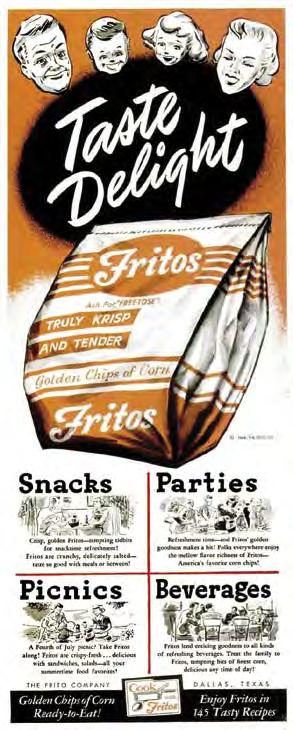
San Antonio, Texas, resident Gustavo Olguin wanted to return to Oaxaca, a Mexican state. Not much is known about Olguin, a cantina or restaurant owner (accounts vary) who may have had a business partner, name unknown. For his customers he created a fried corn chip made from masa, the same type of dough used for tamales (hmmm, tamales). Along with the recipe he had a list of clients and a customized potato ricer for making the chips. Olguin placed an ad in the July 10, 1932 edition of the San Antonio Express: “Corn chips business for sale, a new food product, making good money. Must sacrifice.”
Nearby, Charles Elmer Doolin, whose family owned a confectionary shop, wanted to diversify his family’s offerings and saw the ad. Doolin had tasted Olguin’s chips before, either while eating a sandwich or as part of another dish (again, accounts vary). Doolin paid Olguin the $100 (about $2,200 in today’s dollars) asking price, using money loaned to him from his mother after she sold her wedding ring.
(LEFT) Fritos magazine advertisement, circa 1970.
wife Ruth’s great-grandfather. The Expeditionary Force spent six months chasing Villa through Mexico but he evaded capture, which only added to his legend at home.
The Villa-adjacent Frito Bandito quickly pushed enough buttons that advocacy groups wanted the cartoon mascot withdrawn. Frito-Lay was not willing to end the campaign even while other
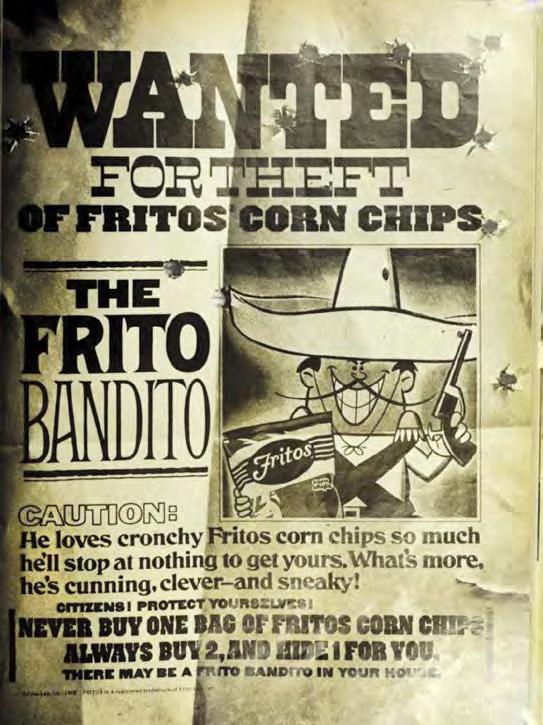
Doolin made improvements to Olguin’s recipe and equipment. Originally, the chips were produced in his parents’ home, with family members providing labor. They were marketed as something to add to recipes but really took off when sold as a separate snack. The Frito Company’s success led it to buy companies with food-canning expertise. This, in turn, led to Doolin wanting to see if “Mexican-Style” food in a can would sell, and it did.
Doolin was always interested in new ways to promote his products. Fritos’ first mascot, the Frito Kid, appeared to be a child cowboy with blond hair that shot out dramatically from under his cowboy hat and a tongue that was perpetually licking his lips. Kid first appeared in 1952 and was designed to appeal to children, their

(RIGHT) A Fritos magazine ad from 1949, aimed at families and minus mascots. © Frito-Lay. Via Archive.org.
Having debuted in 1973 on ABC Saturday mornings, the Super Friends series had already gone through four iterations of the show—and one brief cancellation—by 1979. And although DC’s pantheon of Justice League members were well represented by Superman, Batman and Robin, Wonder Woman, and Aquaman— and aided by the Wonder Twins, Zan and Jayna, with their space monkey, Gleek—every new Fall season seemed to bring another title change and another tonal switch for the heroes.
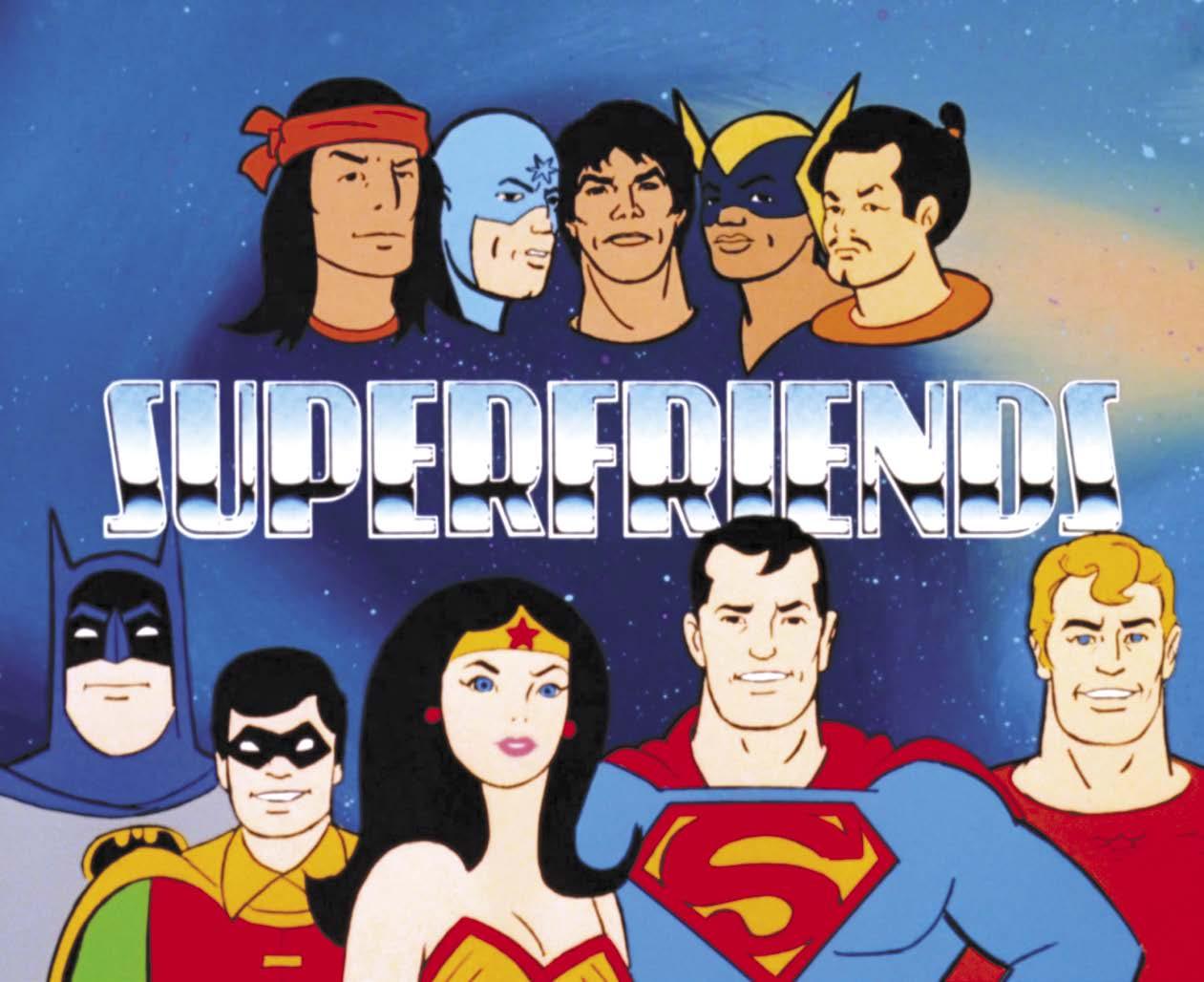
From 1979 to 1983, though, the SuperFriends series—now with a single-word name—would not only undergo four different titles, but also saw syndication expand their market, the network cancel them again, and an animation studio committed to not let the ending be “the end.”
In the last two issues, we examined the first two versions of Super Friends, ABC’s 13-year Saturday morning hit, and now we’ll look at the middle seasons. And watch for the next issue of RetroFan as Andy Mangels’ Retro Saturday Morning wraps up your guide to the longest-running animated super-hero series ever!
The blaring orchestra and William Woodson’s narration opened the new series on September 22, 1979: “It’s The World’s Greatest SuperFriends! Batman and Robin… Superman… Wonder Woman and Aquaman… the Wonder Twins… banded together to protect the universe from the forces of evil. The SuperFriends! Dedicated to Truth, Justice, and Peace for all mankind! The World’s Greatest SuperFriends!”
The World’s Greatest SuperFriends series was one hour long, with the first half consisting of reruns from previous seasons (mostly the half-hour episodes from the 1977–1979 seasons), and the second half of it being a new 22-minute show. Scheduled early in the morning, World’s Greatest SuperFriends led into another show based
Second revised title card for The World’s Greatest SuperFriends. (TOP LEFT TO RIGHT) Apache Chief, the Atom, El Dorado, Black Vulcan, Samurai, and (BOTTOM LEFT TO RIGHT) Batman, Robin, Wonder Woman, Superman, and Aquaman. © DC Comics.
on a DC Comics property, The Plastic Man Comedy/Adventure Show That series starred the stretchable hero who first appeared in 1941 adventures for Quality Comics, before being purchased by DC and reintroduced in the pages of 1966 comics. He had also had a guest appearance in the first season of Super Friends
For reasons lost to time, Hanna-Barbera decided to produce only eight new episodes for the World’s Greatest SuperFriends season, about half of what a normal order would be. The choice was made to do full-length stories that followed the core Super Friends, as they had mostly done in the second half of the Challenge of the SuperFriends stories. Interspersed between each story were short interactive segments with the characters often speaking directly to viewers: Safety, Health, and Crafts reels. Sadly, these shorts were cut from the DVD later release, and are not commercially available.
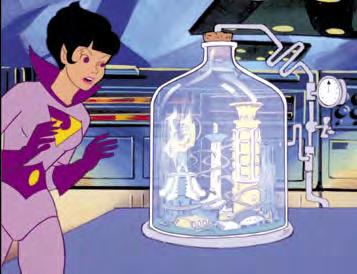
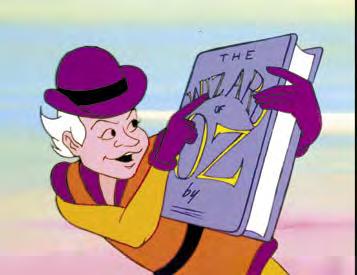
Writer Jeffrey Scott wrote the scripts for the World’s Greatest SuperFriends episodes, though he took story direction from comic-book creators Rick Hoberg and Will Meugniot, as well as Don Sheppard, Emilie Kong, and Larry Latham. Comic artists Jack Kirby and Mike Sekowsky also contributed character designs; although Kirby wasn’t known at the time for the mainstream DC characters, Sekowsky was a longtime penciller of the Justice League of America series!
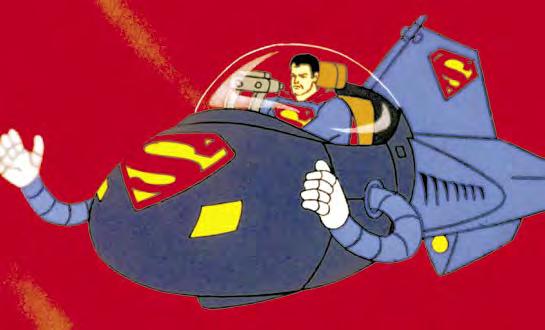
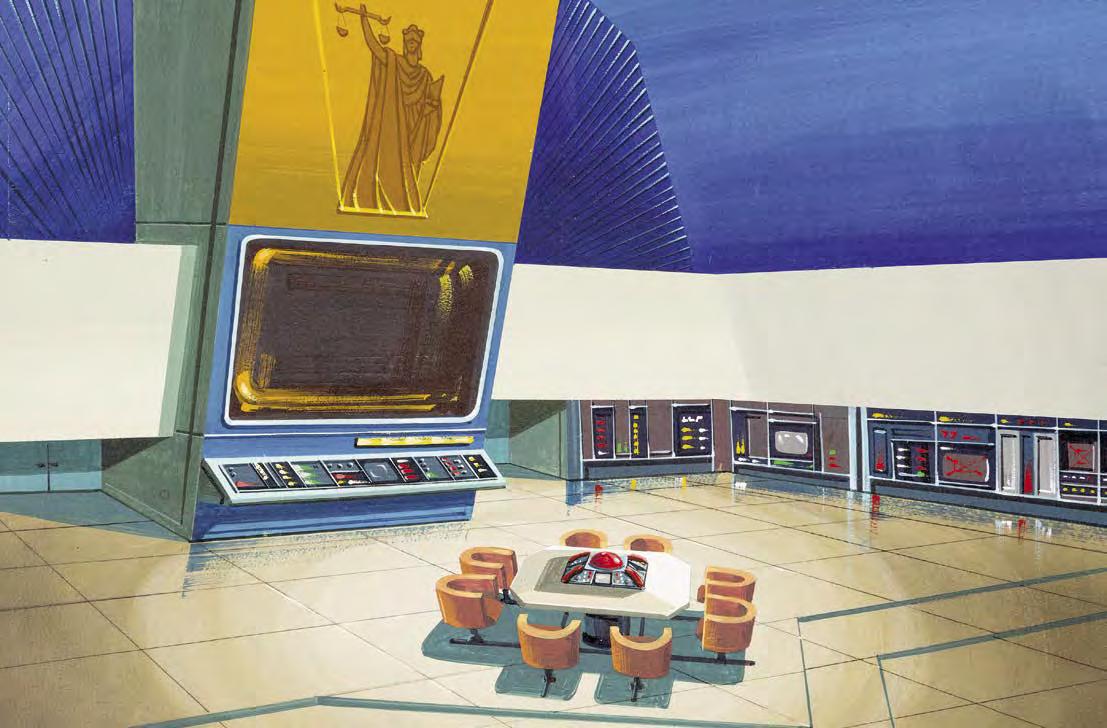
When I was a kid, I wanted to have one of four professions when I grew up: a paleontologist, a cartoonist, a kids’ show host who aired cartoons on TV, or a weirdo who would introduce and make fun of monster movies on TV as a horror host.
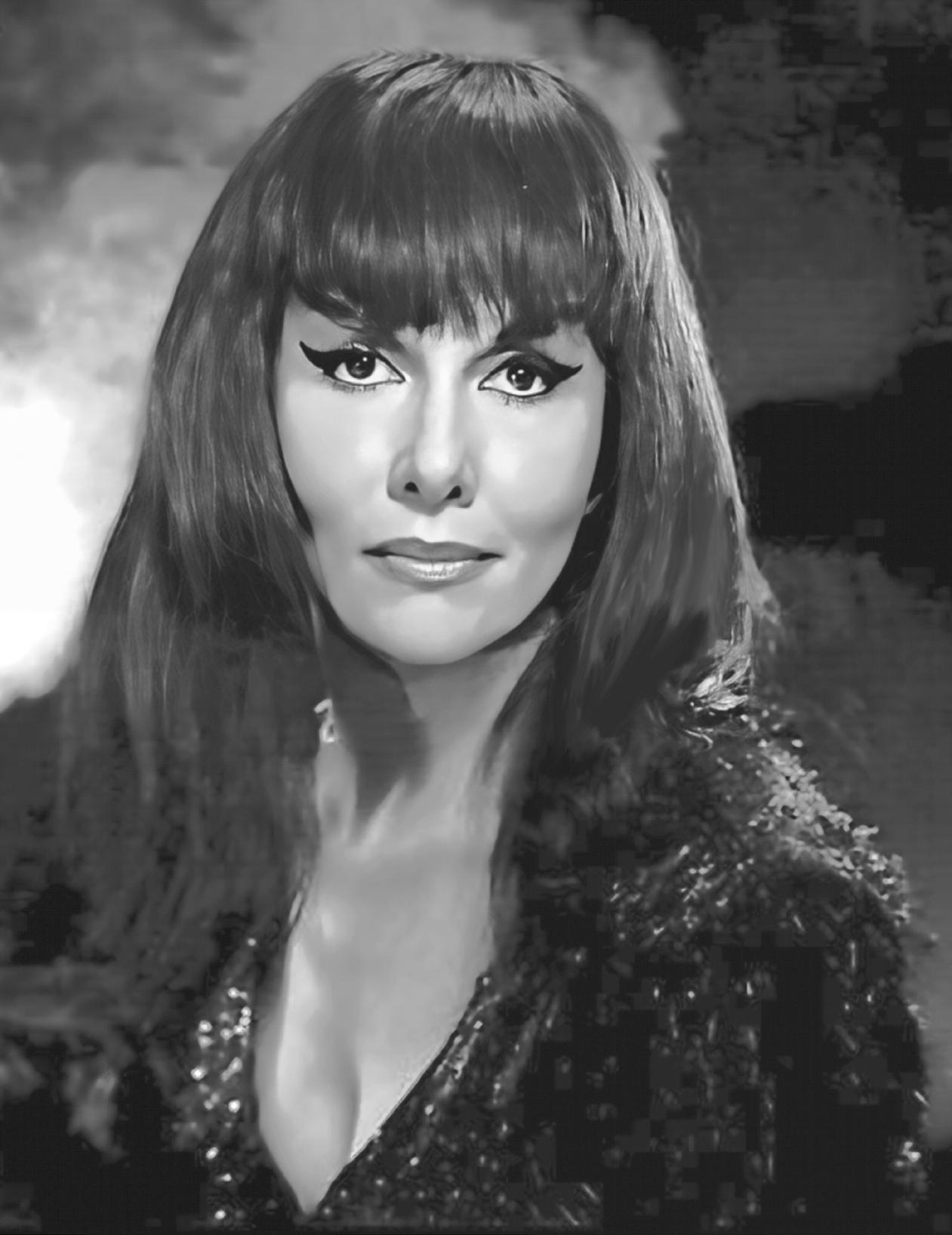
Of course, I never grew up. Ask my family! At least one of those goals worked out for me.
So, what was it like to be a 12-year-old monster-boy when an attractive horror hostess from the Moon provided the finest cheese of low-budget sci-fi entertainment every Saturday afternoon? I should know. It was the same year that I read my first issue of Famous Monsters of Filmland (specifically, the 22nd issue, coverdated Apr. 1963) when, in March 1963, Science Fiction Theater premiered on Saturday afternoons at 4:00 P.M. on KOGO-TV, Channel 10 in San Diego, California. The show ran Fifties-vintage monster/horror/sci-fi
movies. Moona Lisa was its female horror hostess. And if you ever watched her host Science Fiction Theater, it’s very likely that you never forgot her.
In case you missed RetroFan #2 (cover-featuring Elvira) and #6 (with Svengoolie), here’s a bit of history that should explain what horror hosts are and how they were spawned.
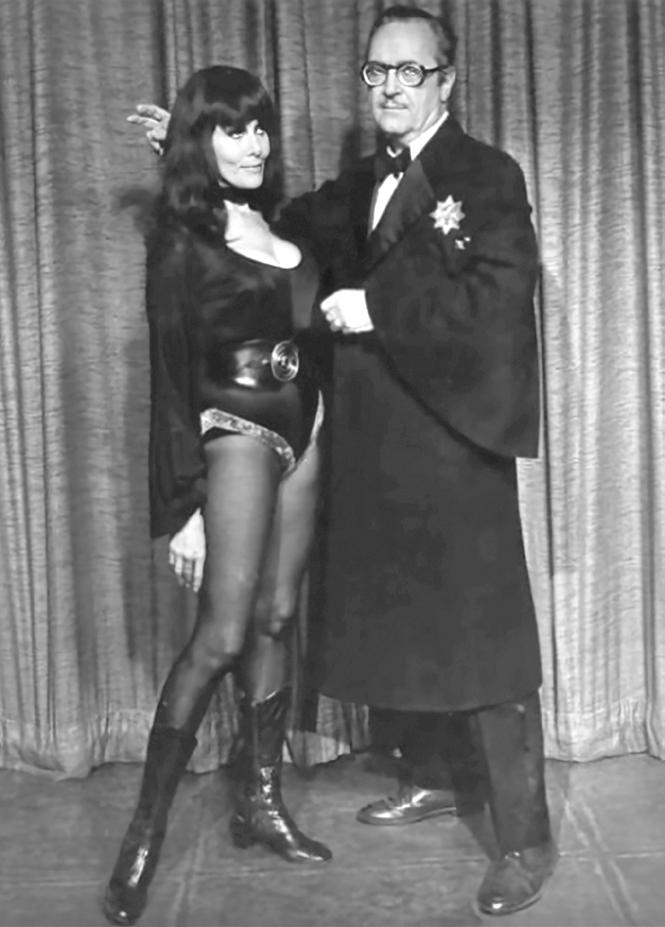
The first TV horror host was actually a horror host ess, Los Angeles’ Vampira, portrayed by Maila Elizabeth Syrjäniemi, a.k.a. Maila Nurmi. Vampira hosted The Vampira Show (KABC-TV, 1954–1955), in which she introduced scary, suspenseful movies and appeared in commercial breaks. She also was seen in the films The Beat Generation and Ed Wood’s Plan 9 from Outer Space. Her make-up and costume were closely based on cartoonist Charles Addams’ gaunt beauty Morticia, a decade before the 1964 debut of ABC’s The Addams Family
In October 1957, Universal Studios released 52 pre-1948 monster/horror/ suspense films through Screen Gems for syndication on television. Local stations that bought the package aired the movies in two-hour slots (with commercials) on weekends, usually late at night, under the blanket title Shock Theatre. In 1958, 20 more films from those genres were released to television as Son of Shock. Teenage monsters, atomic mutants, and sky-high kaiju had been the stars of a popular wave of new and profitable low-budget movies since the early Fifties [see last issue’s Teenage Monsters article for more info —ed.]. There was one problem. Most of the movies in both releases were far less than two hours in length, and a few were barely an hour long. Even after the time consumed by multiple TV commercials, there was still a significant amount of time to fill. And that’s when someone thought that a having a spooky “host” to introduce and joke about whatever movie was scheduled. A New York City actor named John Zacherle was hired to be Roland, the horror host of WCAU’s Shock Theater, which first aired on October 7, 1957. Dressed like an unhealthy undertaker, Roland lived in a
crypt with his departed wife “My Dear” and his lab assistant Igor. In 1958, thanks to his college pal and American Bandstand creator Dick Clark—who christened Zacherle (also spelled “Zacherley”) as “The Cool Ghoul”—with the assistance and backing of Clark in 1958, he recorded a 45rpm record, “Dinner With Drak,” which broke the Top Ten nationally.
The monster craze began to accelerate. Before long, most of America’s major cities had at least one local horror host to call their very own.
But the lucrative (ha!) horror-host industry was occupied almost entirely by men, even though a woman created the concept. Horror hosts were primarily men who already worked for a local television station—announcers, weathermen, and kids’ show hosts were often approached—who were offered the job because they were naturally funny guys who were open to putting on a costume and telling corny monster jokes on Saturday nights in exchange for a few more bucks— very few!—added to their pay envelope. Some horror hosts, like Ernie Anderson and Gene Moss, went on to very legitimate careers doing voiceover announcing for major TV networks. But that was many years ago. Now, for the most part, local stations barely have the funds for competent news shows, let alone horror hosts. Fortunately, we still have MeTV’s Svengoolie, a beloved Chicago horror host portrayed by Rich Koz, who’s enjoyed fame and rubber-chicken pelting after over 40 years of playing Svengoolie. There are a lot of other new horror hosts out there, all on the Internet.
The horror-host craze included the San Diego television market, with a lovely lady named Moona Lisa who lived on the Moon. She had long, straight, black hair with bangs and wore stiletto heels and a mod, black catsuit that showed a bit of cleavage, accessorized with a live python wrapped around her lithe body. Moona Lisa hosted her program from her Moon Base, with the Earth seen in
I can recall in 1964 sitting with my father when we lived in Newton, Massachusetts. I was trying to draw Popeye’s face by making circular shapes. My father suggested I put the circles together, adding a sailor’s cap and pipe. This was one of my earliest attempts at doodling Popeye.
I was the first one to grab the Record Advertiser newspaper in the evening, looking for the comic strips. I avidly followed Popeye’s newspaper adventures by Bud Sagendorf.
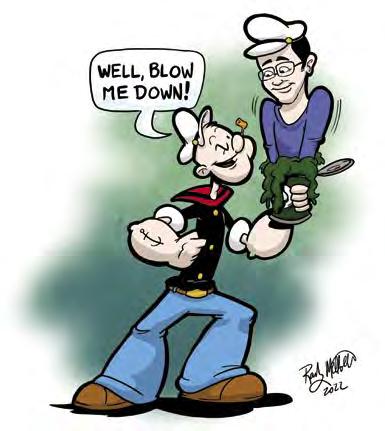
Relatives always kept my passion for Popeye alive. My Aunt Rose Rizzo worked for Red Cross Pharmacy, located in Waltham, Massachusetts. She would bring me home Popeye toys usually sold on the spin racks. When I was three years old, I needed my tonsils taken out, and my Aunt Kaye DeMeo bought me an Olive Oyl doll while I was recovering.
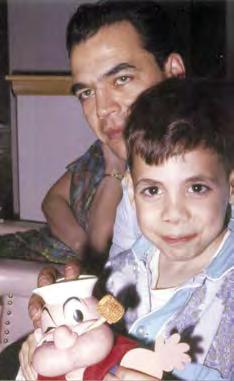
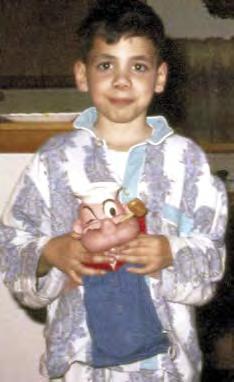
I recall some of my earliest Popeye items being Popeye’s Playbook by Whitman (1961) and the colorful Popeye Trace and Erase Slate Book by Mego (1966).
When we moved to Watertown, Massachusetts, in 1966, our new home was closer to nearby big department stores. My parents let me roam the toy departments, and I yelled “Popeye!” whenever I saw him on the shelf. Zayres, located in Waltham, and Child World, in Natick, were big suppliers of Popeye merchandise. I fondly remember my father bringing me home the Talking Popeye hand puppet by Mattel in 1967. Unintentionally, he proved to me who was the real Santa Claus. In 1968, while in bed on Christmas Eve, I heard my father huffing and puffing. The next morning my brother and
Fred
I headed for our gifts and I walked right past a Popeye bop bag by Coleco. I had to explain to my bewildered father that I heard him blow it up the night before.
On Saturday mornings, my brother Dominic (Dom) and I always watched Rex Trailer’s [kids’ television show] , which aired several different cartoons. When I was a Cub Scout, our troop was on an episode of the long-running series. The director told the scouts to watch the children playing a game. My back was turned around watching the cartoon “Popeye and the Pirates” on a small black-and-white television set. Oddly enough, the morning this episode was broadcast, Boomtown aired all-color Popeye theatricals from Famous Studios. My mother said they did it because I was on the show.
The BRITISH INVASION of the Sixties, interview with Bond Girl TRINA PARKS, The Mighty Hercules, Horror Hostess MOONA LISA, World’s Greatest Super Friends, TV Guide Fall Previews, the Frito Bandito, a Popeye Super Collector, and more fun, fab features! Featuring columns by ANDY MANGELS, WILL MURRAY, SCOTT SAAVEDRA, SCOTT SHAW, and MARK VOGER! Edited by MICHAEL EURY

(84-page FULL-COLOR magazine) $10.95 (Digital Edition) $4.99
https://twomorrows.com/index.php?main_page=product_info&cPath=98_152&products_id=1705
Going through the Watertown public school system was difficult. I was brutally bullied for being involved in art and theater. I was tossed against lockers, tripped in the halls, pushed down flights of stairs, and had gum thrown in my hair. I would come home very depressed, but thankfully a Popeye theatrical cartoon was always waiting for me to watch on WMUR-TV’s The Uncle Gus Show. I would put a sketchpad on my lap and attempt to draw what I was watching. At an early age I recognized what the word “animator” meant, and it was this person, or persons, who decided what Popeye looked like in a particular film. When I discovered the book Popeye the Sailor by Nostalgia Press (1971) and the work of the sailor’s creator E. C. Segar, a new Popeye universe had opened up for me. From Segar I read the works of Bela Zaboly, Tom Sims, and Ralph Stein. Each of these talented individuals put their own spin on Popeye’s comic strip adventures.
Near the holidays in 1984, I came across a publication that listed the names of people